IPQ9574/Ultra-fast speed, ultra-low latency: key advantages and application prospects of WiFi 7
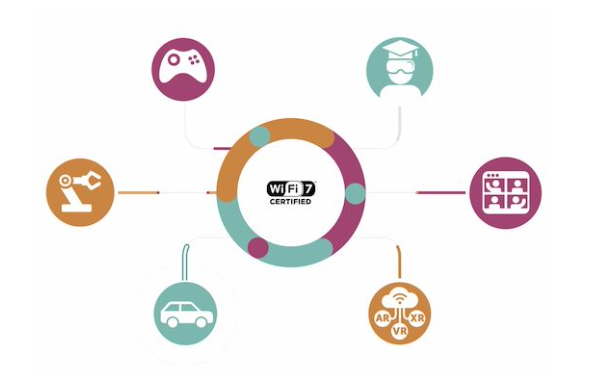
In January 2020, Wi-Fi Alliance officially announced the opening of 6 GHz (5 925 MHz–7 125 MHz) and gave it a new name Wi-Fi 6E. In April of the same year, the US FCC (Federal Communications Commission) also voted to approve it. The 6 GHz spectrum is opened as an unlicensed band and allowed to be used by Wi-Fi. Wi-Fi has officially entered the "tri-band" era, in addition to Wi-Fi 6 and the 2.4 GHz used by the previous generation of Wi-Fi. As well as the 5 GHz band, Wi-Fi 6E can also operate in the 6 GHz band.
In mid-2021, some mainstream Wi-Fi equipment manufacturers on the market began mass production and sales of Wi-Fi 6E products. Starting from 2022, Wi-Fi 6E has become the mainstream specification on the market, regardless of the bidding of European and American operators. The solution is still high-end home Wi-Fi network equipment such as home routers, Mesh, wireless signal extenders and even high-specification laptops, etc. have included Wi-Fi 6E in the basic specifications. Just as everyone is gearing up to welcome Wi-Fi When the 6E era arrives, Wi-Fi 7 has occupied most of the Wi-Fi industry and technology-related pages at lightning speed. Why does Wi-Fi 7 attract most people's attention? What new technological innovations does Wi-Fi 7 have compared to previous Wi-Fi technologies? What's its current status? Below we will discuss these issues.
What is Wi-Fi 7?
Before we discuss Wi-Fi 7, let’s review the evolution and technical highlights of past generations of Wi-Fi specifications. At the end of 2018, in order to simplify the complex naming of Wi-Fi standards, Wi-Fi Alliance officially renamed the original 802.11ax to Wi-Fi 6. At the same time, retroactively, the existing 802.11ac was changed to Wi-Fi 5. , 802.11n was renamed Wi-Fi 4

In 2020, Wi-Fi 6E came out immediately after Wi-Fi 6. Wi-Fi 6E opened the 6 GHz frequency band for Wi-Fi to use. Since then, Wi-Fi has officially entered the "true tri-band" architecture (2.4 GHz/5 GHz/6 GHz Tri-Band architecture)

The Wi-Fi standard currently remains at Wi-Fi 6E. Scientists, scholars and members of IEEE and Wi-Fi Alliance are discussing and proposing technical specifications and MRD (Marketing Requirements Document) related to Wi-Fi 7. According to Wi-Fi Fi Alliance's latest meeting minutes, the latest MRD document has been officially approved by WFA in March 2022, and the IEEE working group will also publish the latest IEEE P802.11be™/D2.0 standard draft in March 2022 document.
The IEEE specification that Wi-Fi 7 follows is 802.11be-Extremely High Throughput (ETH). Compare Wi-Fi 4’s HT (High Throughput), Wi-Fi 5’s VHT (Very High Throughput), and Wi-Fi 6’s HE (High Efficiency), Wi-Fi 7, as the name suggests, pushes the throughput of Wi-Fi even higher.
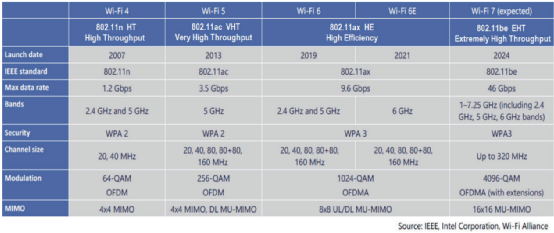
Regarding the specifications, new technologies and new functions of Wi-Fi 7, the following figure lists several new technologies that are currently the most discussed and play a key role.
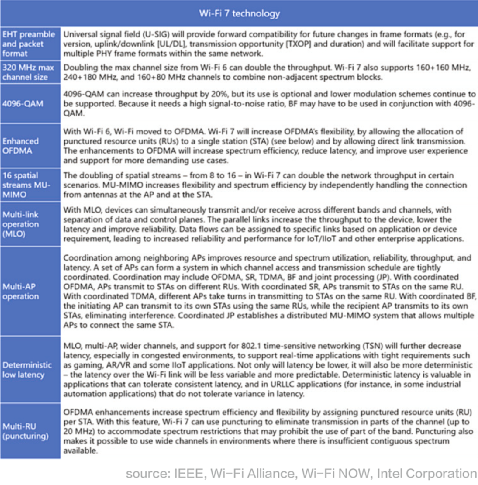
Wi-Fi 7 continues the spirit of the previous Wi-Fi 6, hoping to use some new technologies to improve the throughput of network transmission and improve the efficiency of Wi-Fi networks. Wi-Fi has been known since it was invented from the beginning. A highly efficient architecture, especially in multi-user, high-density network environments, will highlight the shortcomings of Wi-Fi networks, such as interference of Wi-Fi working frequency bands (Interference of ISM Bands), due to time-sharing switching of multiple tasks Time out (Handshaking Time Out) caused by delay, asymptomatic throughput of Up-link and Down-link (Asymptomatic Throughput of Up-link and Down-link), etc... plus the wireless network used by Wi-Fi The frequency band is "free", so the waste of frequency band resources and low efficiency caused by Wi-Fi technology itself is indeed a big gap compared with the 3G, LTE and 5G technologies used in mobile communications. This is why IEEE and WFA have never Wi-Fi 6 began to decide to import key technologies of LTE such as OFDMA, Resource Unit, and MU-MIMO into Wi-Fi. At the same time, this is also the reason why Wi-Fi 6 was named HE (High Efficiency) in the IEEE specification as mentioned before. The origin of.
In order to make Wi-Fi network transmission more efficient, Wi-Fi 7 has developed many innovative new features. Among them, the most critical, most anticipated, and most discussed one is: multi-link operation (MLO) , Multi-resource unit (MRU) and Multi-AP Operation. Multi-AP operation.
Multiplex connection operation MLO
The main purpose of multi-channel connection operation is to allow Wi-Fi devices to transmit and receive data simultaneously through different frequency bands (2.4 GHz / 5 GHz / 6 GHz Bands) and channels (Channels), and according to the current traffic conditions and needs For load balancing or data aggregation, since all work can be done across frequency bands and channels, the transmission speed of the entire network system is greatly improved and the cost of simultaneous online transmission of multiple users is reduced. resulting delays.
The Wi-Fi technology currently on the market allows a Wi-Fi device to use 2.4 GHz, 5 GHz or 6 GHz frequency bands to transmit data, but only one frequency band can be used at the same time, and switching between different frequency bands requires A certain switching time will cause delays in the network system. For some applications that are relatively sensitive to delays, such as wireless VR devices, real-time multiplayer high-definition online games, metaverse, etc..., how to reduce the delay time is an urgent need. To solve the problem, Wi-Fi 7's MLO technology has found a solution to this problem. The figure below illustrates that WiFi 7 MLO can transmit simultaneously through different frequency bands.
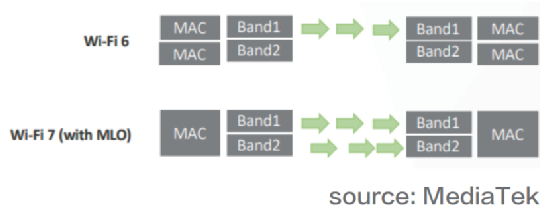
As mentioned above, throughput and latency can be improved through MLO
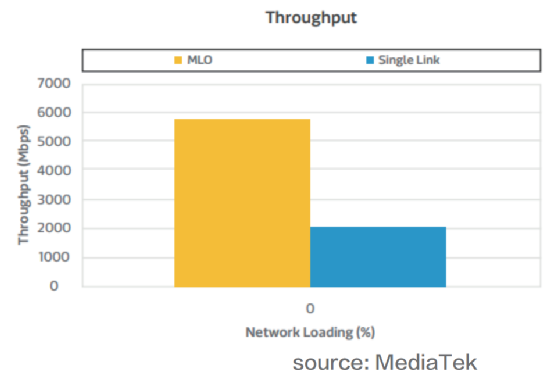
Advantages of MLO - Throughput
Wi-Fi 7 MLO (2×2 BW160+2×2 BW320) vs. Wi-Fi 6SL (2×2 BW160)
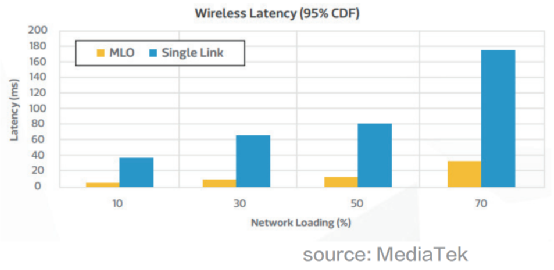
MLO Advantages-Wireless Network Latency
Wi-Fi 7 MLO (2×2 BW40+2×2 BW160) vs. Wi-Fi 6 SL (2×2 BW160)
MLO has several different operating modes. From the document data published by Intel, four typical MLO types are listed. According to the difficulty, complexity and performance of their deployment, they are MLSR, eMLSR, Non-STR MLMR and STR respectively. MLMR, the conclusion is: the more MLO modes that support simultaneous operation of multiple wireless signals, the greater the performance improvement in throughput or latency; however, the more complex the MLO, the greater its hardware requirements and the complexity of the software algorithm program. The higher it is.

Types and performance differences of MLO
Another Wi-Fi chip provider, MediaTek, has proposed an MLO architecture called "Hybrid eMLSR". The principle of eMSLR is to connect three different frequency bands (2.4 GHz, 5 GHz, 6 GHz) through 2 Radio to transmit, one Radio only transmits 2.4 GHz and is set to STR mode, while the other Radio is set to eMSLR mode and transmits in the 5 GHz and 6 GHz frequency bands. Hybrid eMLSR achieves better performance than standard eMLSR. If At the same time, mixing different bandwidths for single-channel transmission is more helpful for improving the delay and throughput performance of the overall network system.

Advantages of Hybrid eMLSR - Throughput
Hybrid EMLSR 2×2 BW40+ (1×1 BW160+1× 1 BW320) vs.STR 2×2 BW40+2×2 BW320
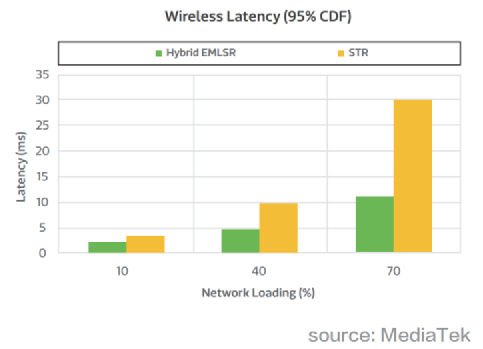
Advantages of Hybrid eMLSR - Wireless Network Latency
Hybrid EMLSR 2×2 BW40+ (1×1 BW160+1× 1 BW320) vs.STR 2×2 BW40+2×2 BW320
MRU (Multiple Resource Unit)
Wi-Fi 7 is based on OFDMA RU and proposes a new mechanism called MRU (Multiple RU) to support the physical layer specification of 802.11be-EHT.
The difference between the MRU proposed by Wi-Fi 7 and the RU of Wi-Fi 6 is that in the RU allocation of Wi-Fi 6, a node can only be allocated one RU, and it cannot be allocated across RUs, while in Wi-Fi With an MRU of 7, a node can be allowed to be assigned to multiple RUs.
Another benefit of MRU is that it can reduce the impact of interference on available channels and enhance the efficiency of OFDMA. Preamble Puncturing technology was introduced in Wi-Fi 6, but in Wi-Fi 7, combined with the characteristics of MRU, Preamble Puncturing can work The mechanism is more flexible. Under the Wi-Fi 6 architecture, after Preamble Puncturing is completed, its RU still needs to be allocated to "multiple" users through the OFDMA mechanism. That is to say, in the use scenario of a single user, Preamble Puncturing It is unable to function. Through MRU, all RUs after preamble puncturing can be allocated to one user, and preamble puncturing can still be performed even under discontinuous spectrum (Non-Continuous Spectrum).
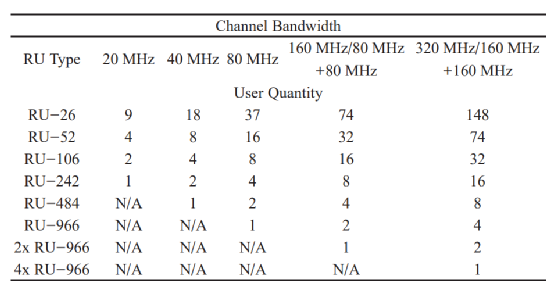
List of all RU combinations based on OFDMA modulation

The MRU of Wi-Fi 7 allows the RU to reduce the loss of available channels caused by signal interference from 75% to 25%. This is why the Wi-Fi 7 Station that supports the MRU function has better performance in multi-user scenarios than the Station of Wi-Fi 6. In high-density network environments, the availability of channel bandwidth can be increased by 3 times
In addition to improving bandwidth availability, Wi-Fi 7 APs that support the MRU function can significantly improve the latency caused by simultaneous transmission scenarios by multiple users.
For example, assume that 4 users require to transmit data of different lengths at the same time. The original data lengths to be transmitted by user 1 to user 4 are 2:2:3:1 respectively. Based on the Wi-Fi 5 AP architecture, in SU(Single User) multi-task transmission mode, it takes a total of 451 μs to transmit all data of 4 users; under the Wi-Fi 6 architecture, OFDMA-RU provides a more efficient transmission method. Since it does not support MRU, It needs to be transmitted in two times. The data length of the first transmission is 1:1:1:1 (RU-484 ton for each user), and the data length of the second transmission is 1:1:2:0 (RU-484 tone for user 1 and user 2; RU-996 tone for user 3), it takes a total of 406 μs to transmit all the data of 4 users; under the Wi-Fi 7 architecture, MRU provides the most efficient transmission method, through different The combination of RU size and the previously mentioned Preamble Puncturing only takes 302 μs to complete the transmission of all users.
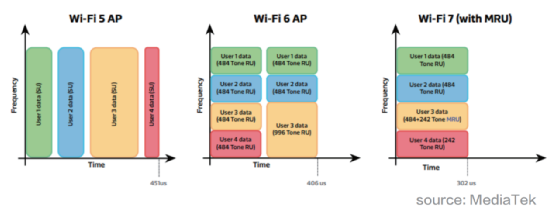
Based on the comparison of end-to-end delays when four users transmit simultaneously under different Wi-Fi specifications, Wi-Fi 7 APs that support MRU can allocate RUs in a more efficient way to shorten the point-to-point delay. Compared with Wi-Fi 5, the delay time can be reduced by 33%; compared with Wi-Fi 6, the delay can be reduced by 25%.
Multi-AP Operation
Multi-AP cooperative operation (Multi-AP Operation or Multi-AP Coordination), like the MLO and MRU mentioned before, is a new technology that Wi-Fi 7 will adopt. In fact, technologies similar to Multi-AP Operation have been around since Wi-Fi 5 has already appeared, and it has an easy-to-understand name - "Wi-Fi Mesh". At that time, Wi-Fi Mesh technology was mainly provided by chip manufacturers, such as Qualcomm's Wi-Fi SON, Broadcom SmartMesh, Therefore, it is inevitable to encounter compatibility issues. Later, the Wi-Fi Alliance defined the standard specification of EasyMesh™ and standardized the Mesh protocol to solve the problem of Mesh compatibility. Wi-Fi Mesh is just the predecessor of Multi-AP Operation. As mentioned in the previous article, most of the previous Wi-Fi Mesh were special functions defined and developed by Wi-Fi chip suppliers, such as mesh network controllers and agents. (Mesh Controller and Agents), Wi-Fi Smart Roaming (Wi-Fi Smart Roaming), etc. In today's 802.11 communication framework (802.11 Protocol Framework), there is not much emphasis on the collaborative operation between AP and AP. Wi-Fi 7, IEEE specifically proposed the specification of Multi-AP Operation to optimize channel selection and load adjustment between APs to achieve the most efficient usage and allow Wi-Fi wireless resources to be allocated fairly and balancedly .
The most important key technology for multi-AP cooperative operation of Wi-Fi 7 is the coordinated scheduling between APs, which must take into account both the time and frequency dimensions as well as inter-cell interference suppression coordination. |coordination; ICIC) and MIMO distribution, etc., the lower the mutual interference between APs, the higher the quality of communication and the availability of wireless signals will be.
Multi-AP Operation has the following deployment methods, namely C-OFDMA (Coordinated Orthogonal Frequency Division Multiple Access), CSR (Coordinated Spatial Reuse), C-CDMA (Coordinated Collision Division Multiple Access), CBF (Coordinated Beamforming) and JXT (Joint Transmission)
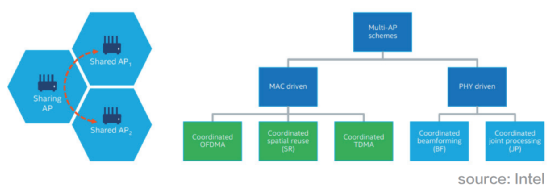
Wi-Fi equipment manufacturers can decide the Multi-AP Coordination method based on different Wi-Fi network architectures and configurations. The five Multi-AP Coordination deployment methods mentioned above are divided into media access layer driver (MAC-Driven). ) (Figure 16) or driven by the physical layer (PHY-Driven) (Figure 17). The coordination method of PHY Driven is relatively easy to implement and the technical threshold is relatively low. The coordination method of MAC Driven is technically more complex. It requires higher construction costs, but the effect is relatively significant.
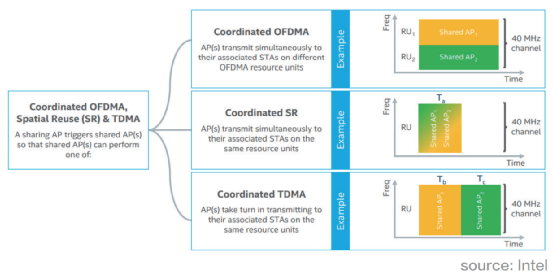
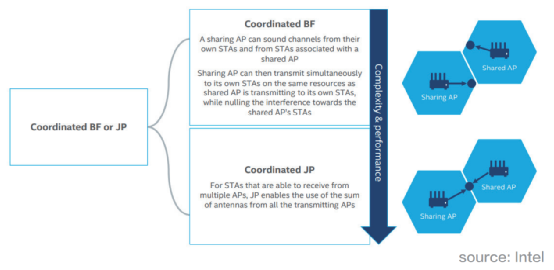
WIFI 7 Product DR9574--IPQ9574
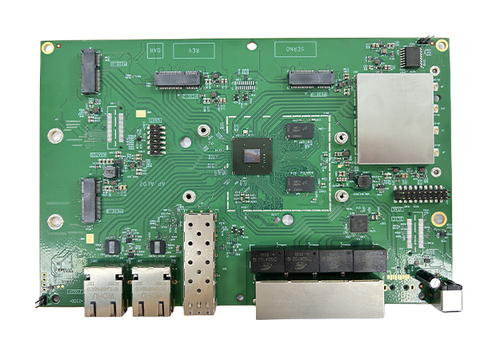
Qualcomm IPQ9574 Quad-Core ARM-A73 @ 2.2GHz processor ‘Alder’ Series








评论